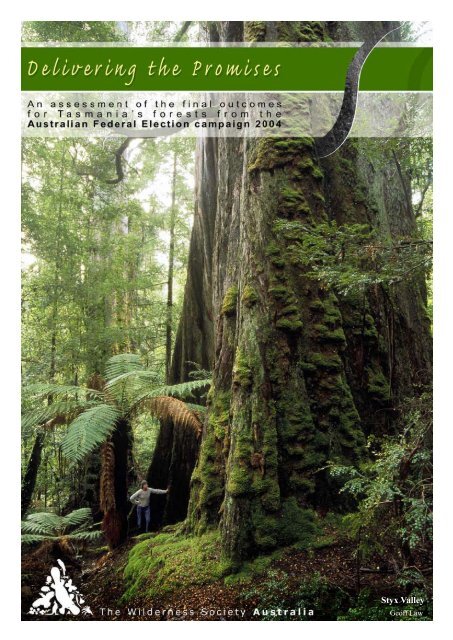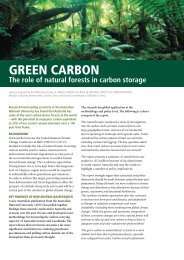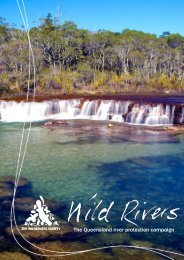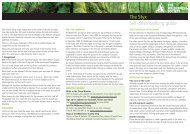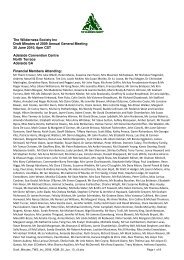Styx Valley - The Wilderness Society
Styx Valley - The Wilderness Society
Styx Valley - The Wilderness Society
Create successful ePaper yourself
Turn your PDF publications into a flip-book with our unique Google optimized e-Paper software.
<strong>Styx</strong> <strong>Valley</strong><br />
Geoff Law
Delivering the Promises Outcomes for Tasmania’s forests from the Australian Federal Election 2004<br />
Background<br />
<strong>The</strong> <strong>Wilderness</strong> <strong>Society</strong> and other national and local conservation groups have<br />
fought hard for the protection of Tasmania’s old growth and high conservation<br />
values forests since the late 1970’s, when the enormity of the impact of an<br />
export wood-chipping-focussed forest industry first became apparent.<br />
Over that period community-based campaigns have been unrelenting,<br />
achieving a series of incremental gains for forest and wilderness protection.<br />
However, in 1997 a major setback, the ‘Regional Forest Agreement’ between<br />
the Commonwealth and Tasmanian Governments, gave most of the forests<br />
around the Tasmanian World Heritage Area and the Tarkine <strong>Wilderness</strong> to<br />
the woodchippers. This not only left many high conservation value areas<br />
unprotected, it sparked one of the biggest episodes of land clearing in<br />
Australian history.<br />
<strong>The</strong> <strong>Wilderness</strong> <strong>Society</strong> and regional conservation groups responded to this<br />
onslaught on Tasmania’s Forests with the <strong>Styx</strong> Campaign as the flagship for a<br />
comprehensive forest protection agenda. <strong>The</strong> campaign stepped up with the<br />
‘Global Rescue Station’ tree sit in the <strong>Styx</strong> <strong>Valley</strong> and a number of large rallies<br />
in Tasmania and Melbourne. <strong>The</strong>se and other activities all over the country<br />
led to high levels of community, media and political pressure, culminating in<br />
the future of Tasmania’s Forests becoming the environmental issue of the 2004<br />
Federal Election Campaign.<br />
Meanwhile, <strong>The</strong> <strong>Wilderness</strong> <strong>Society</strong> with the Australian Conservation<br />
Foundation supported by Greenpeace and other conservation groups prepared<br />
a substantial policy document ‘Protecting Forests Growing Jobs’ that set out a<br />
comprehensive reserve agenda for Tasmania and an industry transition strategy.<br />
Launch of the<br />
Environment Groups’<br />
election campaign.<br />
Alec Marr of <strong>The</strong><br />
<strong>Wilderness</strong> <strong>Society</strong><br />
(centre), flanked by<br />
Don Henry of the<br />
Australian Conservation<br />
Foundation (left) and<br />
Danny Kennedy of<br />
Greenpeace<br />
During the Election campaign, both the Labor and Liberal parties announced<br />
Tasmanian forest protection packages. <strong>The</strong> Liberal Party was swept back into<br />
office with an increased majority.<br />
<strong>The</strong> Government has recently announced the delivery of their package, the<br />
main features of which are outlined below. Many elements of this policy were<br />
drawn directly from ‘Protecting Forests Growing Jobs’.<br />
See: http://www.wilderness.org.au/campaigns/forests/tasmania/protect_forest_make-jobs/<br />
<strong>Styx</strong> <strong>Valley</strong> Geoff Law<br />
<strong>The</strong> <strong>Wilderness</strong> <strong>Society</strong> Australia<br />
2
Delivering the Promises Outcomes for Tasmania’s forests from the Australian Federal Election 2004<br />
Preserving Tasmania’s old growth forests<br />
<strong>The</strong> key elements of the Government’s commitments were:<br />
1. Conservation Commitments<br />
• Immediate protection of an additional 76,100 hectares (188,000<br />
acres) of rainforest in the Tarkine, Southern forests (including<br />
the Huon and Weld <strong>Valley</strong>s) and North East Tasmania;<br />
• immediate protection of 18,700 hectares (46,200 acres) of old<br />
growth forest in the <strong>Styx</strong> and Florentine valleys, and along the<br />
Eastern Boundary of the Tasmanian <strong>Wilderness</strong> World Heritage<br />
Area (WHA);<br />
• immediate protection of an additional 29,600 hectares (73,100<br />
acres) of old growth forest on the Eastern Tiers, Tasman<br />
Peninsula and North East Highlands (including the Blue and<br />
Great Western Tiers) and Central Highlands;<br />
6,000 people march in the <strong>Styx</strong><br />
<strong>Valley</strong> in a rally organised by<br />
<strong>The</strong> <strong>Wilderness</strong> <strong>Society</strong><br />
Ted Mead<br />
• immediate protection of 1,300 hectares in the sub alpine areas;<br />
• immediate reservation of an additional 43,200 hectares (106,700<br />
acres) of private land to the reserve system through voluntary<br />
sale or convenanting;<br />
• the addition of 2,400 hectares (5,900 acres) of forest at Mole<br />
Creek adjacent to the Mole Creek National Park;<br />
• an investment of $2 million in researching alternatives to clear<br />
felling to increase forest yield and provide sustainable forest<br />
jobs;<br />
• an end to the use of 1080 poison baits (which kill native<br />
wildlife) on both public and private land as soon as possible and<br />
no later than December 2005;<br />
<strong>Wilderness</strong> <strong>Society</strong> campaigners<br />
in the <strong>Styx</strong><br />
• an investment of $1 million on a study of the chemical residues<br />
from farming and forestry practices in Tasmanian river<br />
catchments; and,<br />
• $2 million over 2 years to help accelerate research efforts to find<br />
a cure for the facial tumour disease killing the Tasmanian Devil.<br />
Tarkine rainforest Ted Mead<br />
<strong>The</strong> <strong>Wilderness</strong> <strong>Society</strong> Australia 3
Delivering the Promises Outcomes for Tasmania’s forests from the Australian Federal Election 2004<br />
Preserving Tasmania’s old growth forests<br />
2. Industry Commitments<br />
• $5 million to assist with the project costs of the development of<br />
an environmental best practice pulp mill in Tasmania;<br />
• $10 million over two years to assist the softwood industry<br />
establish a plant for the environmentally friendly preservation of<br />
pine and phase out Copper Chrome Arsonate (CCA) within two<br />
years;<br />
• $20 million over four years to improve sawlog recovery rates<br />
(including upgrading mills to process different grades of saw<br />
logs) and to assist forestry businesses to adjust to any reduction<br />
in supplies;<br />
• $4 million over 4 years to facilitate the introduction of new<br />
technologies, new markets, new product lines and re-tooling<br />
options to assist country sawmills;<br />
World’s tallest Christmas<br />
Tree, <strong>Styx</strong> <strong>Valley</strong>, set up by<br />
<strong>The</strong> <strong>Wilderness</strong> <strong>Society</strong> in<br />
December 1999<br />
• $1 million over 2 years to assist the development of the Tarkine<br />
Bush Walk.<br />
Overall, the Election commitments were well short, in both<br />
conservation and $ terms, of what was required to solve the forest<br />
problems in Tasmania.<br />
<strong>The</strong> Global Rescue Station,<br />
<strong>Styx</strong> <strong>Valley</strong>, set up by <strong>The</strong><br />
<strong>Wilderness</strong> <strong>Society</strong> and<br />
Greenpeace, November 2003<br />
to April 2004<br />
<strong>The</strong> <strong>Wilderness</strong> <strong>Society</strong> Australia 4
Delivering the Promises Outcomes for Tasmania’s forests from the Australian Federal Election 2004<br />
May 2005 Tasmanian forest outcomes<br />
<strong>The</strong> package released by the Federal Government in May exceeded<br />
expectations in some areas and fell well short in others.<br />
Importantly, the Coalition has increased it’s funding commitment from<br />
$52 million to $250 million – an amount of money that could be applied<br />
to either increase the rate of old growth forest destruction or facilitate<br />
industry transition to enable greater forest protection.<br />
Our challenge is to ensure the latter occurs. We have a political<br />
opportunity to achieve this in the lead up to the next Tasmanian State<br />
election (due between March – September next year).<br />
At the time of publication of this report no digital data was available to<br />
verify the outcomes. <strong>The</strong> figures are as provided by Government.<br />
Summary<br />
On public land 141,000 additional hectares (348,000 acres) will be<br />
protected. 120,000 hectares (296,000 acres) is old growth forest.<br />
In addition, a generous forest conservation fund will be established to<br />
protect a further 45,600 hectares (110,000 acres) of forest on private land.<br />
On the crude numbers the Government has matched its commitment in<br />
area, and has significantly improved the level of rainforest protection.<br />
However, the tall, wet, highly productive mixed eucalypt rainforests are<br />
still significantly underprotected, with 60% or less of remaining old growth<br />
safe from logging.<br />
Rainforest in the<br />
Tarkine <strong>Wilderness</strong><br />
Ted Mead<br />
<strong>The</strong> Tarkine <strong>Wilderness</strong><br />
<strong>The</strong> outcome for the Tarkine wilderness rainforests was outstanding with the Australian Government<br />
probably exceeding its own policy target.<br />
Area Protected<br />
73,512 hectares (181,500 acres)<br />
(mostly rainforest)<br />
What was needed<br />
(as proposed in “Protecting Forests Growing Jobs”)<br />
85,000 hectares (210,000 acres)<br />
(rainforest, all in the Tarkine)<br />
In addition, a number of large informal reserves have been created in the adjacent Leven Canyon Area.<br />
This outstanding area now needs to be nominated for World Heritage Listing.<br />
<strong>The</strong> <strong>Wilderness</strong> <strong>Society</strong> Australia 5
Delivering the Promises Outcomes for Tasmania’s forests from the Australian Federal Election 2004<br />
Rainforest in the Tarkine <strong>Wilderness</strong><br />
Ted Mead<br />
<strong>The</strong> <strong>Styx</strong> and Upper Florentine<br />
(and proposed eastern boundary extensions to the Tasmanian WHA)<br />
<strong>The</strong> outcome for the <strong>Styx</strong> was average, but very poor for the Upper Florentine. <strong>The</strong> Government did not<br />
meet its policy target for the latter area. Only some small informal reserves were created in the Upper<br />
Florentine - a very, very poor outcome for forests of outstanding international value, which had been<br />
proposed by <strong>The</strong> <strong>Wilderness</strong> <strong>Society</strong> as additions to the Tasmanian <strong>Wilderness</strong> World Heritage Area.<br />
Area Protected<br />
(only formal reserves have been<br />
identified by Government)<br />
<strong>Styx</strong> and Upper Florentine valleys<br />
4,546 ha (11,100 acres) of formal<br />
reserves + some large informal reserves<br />
in the <strong>Styx</strong> on the Jubille Range<br />
What was needed<br />
(as proposed in “Protecting Forests Growing<br />
Jobs”)<br />
Approximately 30,000 ha (74,000 acres) in the<br />
<strong>Styx</strong> and Upper Florentine. Approximately<br />
50,000 ha (124,000 acres) of Eastern Tasmanian<br />
WHA extensions.<br />
<strong>The</strong> Florentine <strong>Valley</strong><br />
Rob Blakers<br />
<strong>The</strong> <strong>Wilderness</strong> <strong>Society</strong> Australia 6
Delivering the Promises Outcomes for Tasmania’s forests from the Australian Federal Election 2004<br />
Eastern Tiers, Tasman Peninsula and North East Highlands<br />
(including the Blue Tier and Great Western Tiers) and Central Highlands<br />
<strong>The</strong> outcome for these areas was very patchy and it is only possible to look at the overall policy<br />
commitment, which was 29,600 ha (73,100 acres). Most of the protection occurred in the dry less<br />
productive forests on the Eastern Tiers. Most of the overall protection was informal and the outcome<br />
across the north of this region was very poor.<br />
Area Protected<br />
(figures for formal reserves only)<br />
Eastern Tiers (including Wielangta)<br />
4,159 ha (10,300 ac) of formal reserves + some informal<br />
Tasman Peninsula and Bruny Island<br />
Small area of informal reserves.<br />
North East Highlands<br />
1,731 ha (4,300 acres) of formal reserves + small area<br />
of informal reserves.<br />
Ben Lomond<br />
Small areas of informal only<br />
Great Western Tiers<br />
365 ha (900 acres) of formal reserves + some informal<br />
and hydro land<br />
What was needed<br />
(as proposed in “Protecting<br />
Forests Growing Jobs”)<br />
Approximately 30,000 hectares.<br />
(75,000 acres)<br />
Approximately 9,000 hectares.<br />
(22,000 acres)<br />
Approximately 51,000 hectares.<br />
(126,000 acres)<br />
Approximately 16,000 hectares.<br />
(40,000 acres)<br />
Approximately 33,000 hectares.<br />
(82,000 acres)<br />
Ben Lomond<br />
Geoff Law<br />
<strong>The</strong> <strong>Wilderness</strong> <strong>Society</strong> Australia 7
Delivering the Promises Outcomes for Tasmania’s forests from the Australian Federal Election 2004<br />
Outcomes (continued)<br />
1080<br />
1080 poisoning on public land will end by December 2005. However,<br />
the commitment to end all 1080 poisoning of native wildlife will<br />
not be met on private land, where about two thirds of the poisoning<br />
occurs.<br />
Forest Management - Old-growth logging<br />
Old growth logging will continue under changed silvicultural<br />
practices.<br />
Brushtail Possum, dying from 1080<br />
poison used to stop it browsing on<br />
seedlings<br />
80% of unprotected old growth will be clearfelled in patches leaving<br />
30% of the original forest cover in small clumps (aggregated retention<br />
logging).<br />
20% of unprotected old growth will continue to be clearfell logged.<br />
Tasmanian Devil dying from Facial<br />
Tumor Disease, which may be<br />
linked to logging practices<br />
Aggregated retention logging<br />
Other commitments<br />
<strong>The</strong> Government met or exceeded its commitment on funding<br />
catchment studies and Tasmanian Devil facial tumour research.<br />
Land Clearing<br />
<strong>The</strong> conversion of native forests to plantations will cease – provided<br />
the process to implement this decision is properly applied.<br />
Industry opposition to this important environmental outcome is<br />
mounting, and we regard the commitment as fragile.<br />
Eucalyptus plantation, established<br />
on cleared rainforest in the Tarkine<br />
area<br />
<strong>The</strong> <strong>Wilderness</strong> <strong>Society</strong> Australia 8
Delivering the Promises Outcomes for Tasmania’s forests from the Australian Federal Election 2004<br />
Outcomes (continued)<br />
Industry Package<br />
<strong>The</strong> total funding to implement forestry changes in Tasmania is $246.8<br />
million (see the attached Government fact sheet).<br />
<strong>The</strong> $115 million earmarked for “intensive forest management” is both an<br />
area of opportunity and of deep concern. We will be striving to ensure that<br />
this funding is spent on opening up further transition possibilities out of<br />
unprotected old growth and other high conservation value forests. Missspent,<br />
this funding could be used to rapidly destroy remaining HCV forests.<br />
Pressure to intensify native forest logging will dramatically increase if<br />
Gunns Limited is successful in its bid to develop a pulp mill in the NE of<br />
the Tasmania. <strong>The</strong> proposed mill would consume at least 3.2 million tonnes<br />
per year of native forests and plantation wood (up to 80% of supply would<br />
be from native forests).<br />
Post-logging burn<br />
<strong>The</strong> <strong>Wilderness</strong> <strong>Society</strong> is challenging the environmental assessment<br />
process being implemented by the Federal Government for the proposed<br />
pulp mill in the Federal Court of Australia.<br />
Conclusion<br />
While we have had a major breakthrough on one of the most intractable<br />
environmental problems in Australia, there is great urgency around the need<br />
to finish the job.<br />
<strong>The</strong> best short-term political opportunity will be provided by the Tasmanian<br />
State election, where the threat of the Tasmanian Greens gaining the balance<br />
of power could provide a real incentive for both the Labor and Liberal<br />
parties to solve the Tasmanian forest problem.<br />
Already the environmental threats associated with a chlorine, native forestbased<br />
pulp mill are galvanizing public opposition. Continuing the campaign<br />
to protect old growth and other high conservation value forests will help<br />
ensure that the funding put on the table through the recent package is used<br />
to help finally solve the problem.<br />
Actress Olivia Newton-<br />
John in the <strong>Styx</strong>. Many<br />
Australian celebrities have<br />
joined the <strong>Styx</strong> campaign<br />
In addition, both the Federal and Tasmanian Governments now need to<br />
move quickly to cement the positive aspects of this announcement and<br />
nominate the Tarkine – Australia’s largest wilderness rainforest – for World<br />
Heritage Listing.<br />
<strong>The</strong> <strong>Wilderness</strong> <strong>Society</strong> Australia 9
Delivering the Promises Outcomes for Tasmania’s forests from the Australian Federal Election 2004<br />
What was delivered at a glance...<br />
What was delivered<br />
• <strong>The</strong> Tarkine rainforest wilderness has received impressive protection, consistent with<br />
it’s world heritage values, and important areas in the <strong>Styx</strong> will be protected.<br />
• However, high conservation value forests in the North East highlands, Blue Tier, Great<br />
Western Tiers and Ben Lomond remain open to logging.<br />
• <strong>The</strong> Governments’ package now matches the level of funding proposed in our $250<br />
million plan, Protecting Forests Growing Jobs. However, the package allows old<br />
growth forest logging to continue and will support plans for a native forest, chlorinebased,<br />
bleaching pulpmill in the Tamar <strong>Valley</strong>.<br />
• It fails to address the need for a full restructuring of the industry to end old growth<br />
logging, or to properly support tourism jobs. <strong>The</strong> commitment to end the use of 1080<br />
poison has been seriously weakened.<br />
• Broadscale land clearing for plantation establishment, one of the most intractable<br />
problems in Tasmania, is being tackled. While this is a good start, it is crucial both<br />
governments ensure implementation. It is still a major concern that 70,000 ha (173,000<br />
acres) of future clearing will be permitted by the policy.<br />
• <strong>The</strong> <strong>Wilderness</strong> <strong>Society</strong>’s overall rating would be “mediocre,” 4 out of 10.<br />
www.wilderness.org.au<br />
<strong>The</strong> <strong>Wilderness</strong> <strong>Society</strong> Australia 10


